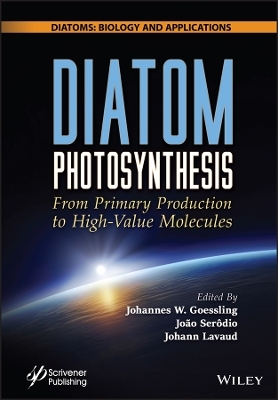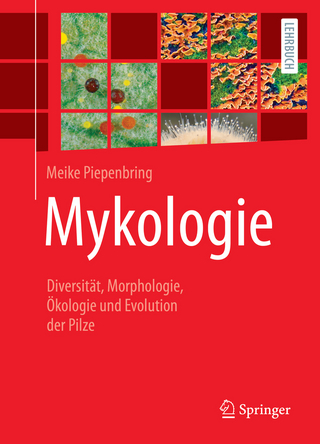
Diatom Photosynthesis
Wiley-Scrivener (Verlag)
978-1-119-84208-8 (ISBN)
Diatoms exert an immense influence on the ecosystem of Earth due to their remarkable abundance and species diversity. Thriving in diverse habitats spanning the oceans, intertidal benthic zones, saline and freshwater environments, and even terrestrial niches like moist soil, forests, and caves, they play an integral role. Diatoms alone account for around 20% of the oxygen generated by photosynthesis, comparable to the combined productivity of tropical rainforests worldwide, while their primary production can reach 40–45% in marine ecosystems. Nevertheless, in contrast to the extensive research on macroscopic photosynthetic organisms, investigations in this domain remain comparatively limited, despite the role of diatoms in global biogeochemical processes.
This book presents an exhaustive review of the subject matter, encompassing a wide spectrum of topics ranging from the intricate molecular mechanisms of diatom photosynthesis and light absorption to the dominant role of diatoms as primary producers within ecological frameworks. Beyond this, the book delves into the practical implications stemming from diatoms and their photosynthetic productivity. A strong emphasis is placed on the importance of fundamental research in deepening our understanding of the natural world around us.
Diatoms Photosynthesis provides readers with a
comprehensive guide to understanding the fundamentals of diatom photosynthesis and their ecological significance in aquatic ecosystems;
a guide to the potential of diatom-derived products for sustainable technologies;
a roadmap from diatom photosynthesis to implications in applied sciences;
a bridge to span the gap between fundamental research on diatoms and their practical applications.
Audience
This book caters to academic professionals, students, and researchers in the fields of marine biology, ecology, microbiology, and biochemistry. It offers insights and benefits into diatom photosynthesis, diatom physiology, biodiversity, ecosystem health, and sustainable technological advancements.
Johannes W. Goessling, PhD, is a researcher in the Department of Biology, Laboratory for Innovation and Sustainability of Marine Biological Resources, Centre for Environmental and Marine Studies, University of Aveiro, Portugal. He received his PhD in marine biology from the University of Copenhagen, with a foundational background in biology, specifically focusing on plant physiology and plant ecophysiology. His research is centered on diatom frustules, investigating their interactions with light, giving rise to photonic properties. His research is regularly published in the top journals in the field. João Serôdio, PhD, is an assistant professor in the Department of Biology at the University of Aveiro in Lisbon, Portugal. He received his PhD in biology from the University of Lisbon in 1999. His research focuses on the photobiology and ecophysiology of marine primary producers with a special emphasis on diatoms. He has authored more than 120 articles in international journals and has authored 7 peer-reviewed book chapters. Johann Lavaud, PhD, is a scientist in the Laboratory for Environmental Marine Sciences at the European Institute for Marine Studies, University of Western Brittany, France. He completed his PhD on the photosynthesis of diatoms in 2002 at the ENS-University of Paris VI. His research focuses on the diversity and productivity of how diatoms are impacted by the environment. His research has been published in more than 80 articles in peer-reviewed international journals.
Preface xxvii
Acknowledgements xxix
Part 1: Evolution and Genetics 1
1 Comparing Diatom Photosynthesis with the Green Lineage: Electron Transport, Carbon Fixation and Metabolism 3
Dany Croteau, Erik Jensen, Christian Wilhelm and Benjamin Bailleul
1.1 Introduction 5
1.2 Conservation and Diversity within Oxygenic Photosynthesis 6
1.3 Consequences of the Secondary Endosymbiosis and Thylakoid Ultrastructure 9
1.4 Different Modes of Photosynthetic Electron Flows 12
1.5 Regulation of CO2 Concentration, CO2 Fixation and Carbon Metabolism 18
1.6 General Response of Photosynthesis to Environmental Stresses 22
1.7 Conclusion 25
2 Genetic Regulation of Diatom Photosynthesis: Understanding and Exploiting Genetic Diversity 45
Charlotte Volpe, Marianne Nymark and Tore Brembu
2.1 Regulation of Photosynthesis 47
2.2 Diatom Genomes 48
2.3 Photosynthetic Components in Diatom Genomes 50
2.4 Responses to Changes in Light Intensity 54
2.5 Circadian Rhythmicity 57
2.6 Responses to Changes in Light Quality 58
2.7 Retrograde Signaling 59
2.8 Gene Editing for Functional Characterization and Commercial Applications 61
2.9 Conclusion 68
3 Evolution of Plastids and Mitochondria in Diatoms 81
Ansgar Gruber and Miroslav Oborník
3.1 Introduction 81
3.2 Origin and Evolution of Diatom Plastids 83
3.3 Derived States of Diatom Plastids 94
3.4 Consequences of Complex Plastid Acquisition 96
3.5 Conclusions and Outlook 100
4 Structure and Dynamics of the Diatom Chloroplast 113
Monika Bojko, Stanislaw Listwan, Reimund Goss and Dariusz Latowski
4.1 Evolution and Structure of Diatom Chloroplasts 114
4.2 Architecture of the Diatom Thylakoid Membrane 118
4.3 Molecular Dynamics and Structure of the Diatom Thylakoid Membrane Under Different Light Conditions 125
4.4 Molecular Dynamics and Structure of the Diatom Thylakoid Membrane Under Different Thermal Conditions 127
4.5 Conclusion 128
Part 2: Interaction with Light 137
5 Pigments in Diatoms: Light Absorption and Beyond 139
Paulina Kuczyñska, Ma³gorzata Jemio³a-Rzemiñska and Kazimierz Strza³ka
5.1 Environmental Factors Affect Pigments in Diatoms 139
5.2 Diatoms are Well Adapted to Changing Light Conditions 141
5.3 Photosynthetic Pigments in Diatoms are Chlorophylls and Carotenoids 143
5.4 The Main Pigment in Diatoms – Chlorophyll a Plays a Central Role in Photochemical Energy Conversion 148
5.5 Chlorophyll c Participates in Photosynthesis as an Accessory Pigment 150
5.6 Fucoxanthin-Binding Proteins in Diatoms Play a Special Role 151
5.7 Regulation of Protochlorophyllide Oxidoreductases was Examined in Diatoms but Further Steps of Chlorophyll c Biosynthesis Remain Unclear 152
5.8 Fucoxanthin is the Main Light-Harvesting Carotenoid in Diatom 155
5.9 High Bioavailability and Bioactivity of Fucoxanthin Makes It a Desirable Compound Obtained by Extraction 158
5.10 Beneficial Effects of Fucoxanthin are Versatile 160
5.11 Diadinoxanthin and Diatoxanthin are Involved in Cyclic Changes, Ensuring Photoprotection 161
5.12 Diatoms Also Possess the Violaxanthin Cycle, but It is not the First Line of Defense Against Excessive Light Energy 163
5.13 Mechanisms of NPQ in Diatoms are Complex and Differ Depending on Species 163
5.14 Many Carotenogenic Enzymes and Genes in Diatoms Have not yet Been Revealed 165
5.15 Analysis and Production of Diatom Pigments are Challenging Tasks with Promising Prospects 167
5.16 Conclusions 170
6 Function, Structure and Organization of Light-Harvesting Proteins in Diatoms 191
Charlotte Volpe and Claudia Büchel
6.1 Introduction 192
6.2 The FCP Proteins 194
6.3 Structure, Pigmentation and Energy Transfer 195
6.4 Macroorganization of FCP-PSI/II Supercomplexes 198
6.5 Role of the Chloroplast Signal Recognition Particle Pathway (CpSRP) 201
6.6 Balancing Light Absorption and Photoprotection 202
6.7 Conclusion 206
7 Sensing Light Underwater: An Update on Photoreceptors in Diatoms 217
Manuel Serif and Per Winge
7.1 Introduction 219
7.2 Rhodopsins 221
7.3 Phytochromes 223
7.4 Cryptochrome/Photolyase Family 226
7.5 Aureochromes 231
7.6 Conclusion 235
8 Non-Invasive Biophysical Techniques to Monitor the Structural Plasticity of the Photosynthetic Machinery of Live Diatom Cells 245
Milán Szabó, Gergely Nagy and Gyözö Garab
8.1 Introduction 246
8.2 Circular Dichroism Spectroscopy 248
8.3 Small-Angle Neutron Scattering (SANS) 253
8.4 Electrochromic Shift Absorbance Transients 256
8.5 Conclusions and Outlook 259
9 Hypotheses on Frustule Functionalities: From Single Species Analysis to Systematic Approaches 267
Johannes W. Goessling, Matt P. Ashworth, Marianne Ellegaard, Joao Serôdio and Martin Lopez Garcia
9.1 Introduction 268
9.2 Frustule Fundamentals: Chemistry, Formation, Reproduction 271
9.3 Examples of Unique Frustule Systems 274
9.4 Physicochemical Properties 277
9.5 Physical Properties 279
9.6 Frustule as an Optical System 281
9.7 Conclusions and Outlook 289
Part 3: Primary Production and Ecology 301
10 Extracellular Polymeric Substance Production by Benthic Pennate Diatoms 303
Graham J. C. Underwood
10.1 Introduction 304
10.2 Types of EPS Produced by Benthic Diatoms 304
10.3 Functions of EPS in Benthic Diatoms in Relation to Chemical Composition 308
10.4 Metabolic Pathways of EPS Production and Regulation in Diatoms 310
10.5 Interactions Between Diatoms, EPS and Bacteria 313
10.6 Future Directions 315
11 Diatom Primary Production in Headwater Streams: A Limited but Essential Process 327
Joey Allen, Michael Danger, Carlos Eduardo Wetzel, Vincent Felten and Martin Laviale
11.1 Ecological Relevance of Headwater Stream Ecosystems 328
11.2 Diatom Primary Production is Highly Constrained in Headwater Streams 330
11.3 Diatoms as High-Quality Resources for Other Organisms 334
11.4 Anthropogenic Impacts on Diatom Contributions to Headwater Stream Functioning 336
11.5 Headwater Diatom Community Functioning is Supported by Unique Biodiversity 338
11.6 Conclusion and Perspectives 340
12 Present and Future Perspectives for Bioassessment of Running Water Using Diatoms 351
Salomé FP Almeida and Maria J. Feio
12.1 Introduction 352
12.2 Potential of Diatoms as Indicators in Running Water Quality Assessment 352
12.3 Water Quality Assessment Methods 353
12.4 Molecular-Based Methods 355
12.5 Transitioning from Morphology-Based to eDNA-Based Biomonitoring: Available Options 368
12.6 Conclusions 370
13 Photosynthetic and Growth Responses of Planktonic Diatoms to Ocean Global Changes 383
Peng Jin, John Beardall and Kunshan Gao
13.1 Introduction 384
13.2 The Effects of Elevated CO2 and Ocean Acidification 384
13.3 The Effects of Ocean Warming 388
13.4 The Effects of UVR 389
13.5 Combined Effects of Ocean Acidification and Warming 390
13.6 Combined Effects of Ocean Acidification and UVR 391
13.7 Combined Effects of Ocean Acidification and Deoxygenation 392
13.8 Ocean Acidification Effects Under Multiple Drivers 393
13.9 Ecological Implications 395
13.10 Conclusions and Recommendations 396
Part 4: Cultivation and Application 407
14 Culturing Diatoms 409
Daniel Vaulot, Gust Bilcke, Peter Chaerle, Angela Falciatore, Priscillia Gourvil, Michael W. Lomas, Ian Probert and Wim Vyverman
14.1 Introduction 409
14.2 Current Diversity of Diatoms in Culture 411
14.3 Isolation of Diatom Cultures 415
14.4 Culture of Diatoms 422
14.5 Life Cycles 424
14.6 Cryopreservation 426
14.7 Diatom Strains Amenable to Genetic Engineering 430
14.8 Conclusion 434
15 Diatom Biofilm: Ecology and Cultivation from Laboratory to Industrial Level 449
Mary Dianne Grace Arnaldo, Aurélie Mossion, Thierry Beignon, Hugo Vuillemin, Freddy Guihéneuf, Gaëtane Wielgosz-Collin and Vona Méléder
15.1 Introduction 449
15.2 Natural Biofilms 453
15.3 Artificial Algal Biofilm Systems 458
15.4 Conclusion and Perspective 467
16 Opportunities and Challenges of Diatom Cell Factory for Human Health 477
Clementina Sansone, Angelo Del Mondo, Luigi Pistelli, Arianna Smerilli, Maria Saggiomo and Christophe Brunet
16.1 Introduction 478
16.2 Carotenoids 479
16.3 Vitamins 485
16.4 Polyphenols 490
16.5 Phytosterols 494
16.6 Polysaccharides 496
16.7 Polar Diatoms: New Model for Biotechnology? 500
16.8 Filling the Gap between Diatoms Biological Traits and Biotechnological Use 503
16.9 Conclusions 507
17 Diatom-Based Bioproducts and the Potential of Frustules in Drug Delivery 529
Pankaj Kumar Singh, Abhishek Saxena and Archana Tiwari
17.1 Introduction 529
17.2 High-Value Products Derived from Diatoms 531
17.3 Diatom as Drug Delivery Carriers 535
17.4 Therapeutic Applications of Diatoms 540
17.5 Conclusion 542
Part 5: Diatoms as Representative Organisms for the Protection of Marine Genetic Resources 551
18 A Journey to Mars with Diatoms on Board 553
Louisa Reissig, Mohamed Ghobara, Christian Maibohm and Johannes W. Goessling
18.1 Introduction 554
18.2 The Living Diatom 556
18.3 The Diatom Frustule: A Sustainable Source of Porous Silica 561
18.4 The Evolving Diatom 568
18.5 Conclusion 571
19 Legal Regime of Marine Genetic Resources in Areas Beyond National Jurisdiction 583
Gemma Andreone, Valentina Rossi and Giovanni Ardito
19.1 Introduction 584
19.2 The Current Legal Framework 585
19.3 The Notion of Marine Genetic Resources 586
19.4 Bioprospecting and Marine Scientific Research: Access to and Collection of Marine Genetic Resources 589
19.5 Spatial Scope (High Seas-Area) and Legal Status of MGRs in ABNJ (Common Heritage of Mankind vs Freedom of the Seas) 593
19.6 Conclusion 597
Acknowledgments 598
References 598
Subject Index 601
Taxonomic Index 611
| Erscheinungsdatum | 21.08.2024 |
|---|---|
| Reihe/Serie | Diatoms: Biology and Applications |
| Sprache | englisch |
| Gewicht | 1678 g |
| Themenwelt | Naturwissenschaften ► Biologie ► Botanik |
| Naturwissenschaften ► Biologie ► Limnologie / Meeresbiologie | |
| ISBN-10 | 1-119-84208-5 / 1119842085 |
| ISBN-13 | 978-1-119-84208-8 / 9781119842088 |
| Zustand | Neuware |
| Informationen gemäß Produktsicherheitsverordnung (GPSR) | |
| Haben Sie eine Frage zum Produkt? |
aus dem Bereich


